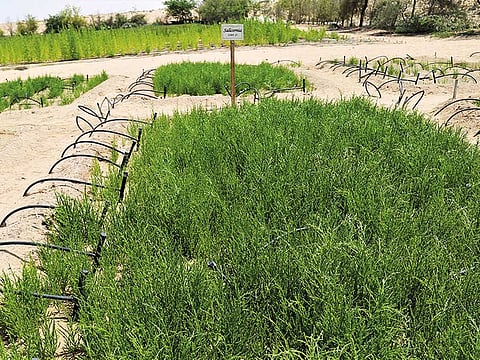Researchers make breakthrough in Salicornia’s harvest potential
Salicornia is a salt-loving plant that has high market value that can be used for food, forage and biofuel production

Dubai: A team of scientists in the UAE has made a major breakthrough in bumping up the harvest potential of Salicornia, a salt-tolerant plant used for food, forage and biofuel production.
Scientists at International Centre for Biosaline Agriculture (ICBA) recently recorded a bumper seed yield of three tonnes per hectare (t/ha) using seawater passing through an aquaculture system. This is the first time Salicornia has produced such high yield under UAE conditions.
ICBA is a centre that studies the potential of growing alternative crops that can thrive under arid conditions in the region.
The salt-loving plant is also known as pickleweed, sea beans, or sea asparagus. This protein-rich plant can be eaten raw, as a salad, or as a side dish. The crop also has a great commercial value due to its high biofuel and forage potential.
Dr Dionysia Angeliki Lyra, a halophyte agronomist at ICBA, said the team is extremely happy to see that their years of our research efforts are bearing fruit as the crop has achieved a great feat.
“One of the main purposes of our research was to identify an alternative crop for multiple uses that is well adapted to marginal saline environments. In particular, we wanted to assess the potential of growing Salicornia under extreme soil and water conditions and select the best-performing lines in terms of seed and biomass production for future breeding and commercial production,” Dr Lyrda said.
ICBA, along with local partners, has carried out extensive studies on the potential of growing Salicornia under arid conditions like in the UAE since 2011.
During several multi-year field trials at the centre’s experimental station in Dubai, scientists evaluated more than 50 different Salicornia genotypes under highly saline conditions and selected the top high-yielding ones.
Dr Lyra said the centre is growing 16 Salicornia genotypes with desirable characteristics at ICBA’s experimental station, out of which the four high-yielding ones are currently cultivated in a coastal desert system in collaboration with the Marine Environment Research Centre’s experimental station, of the UAE Ministry of Climate Change and Environment in Umm Al Quwain.
“So far the results have shown that the plant’s oil content is high and can reach up to 38 per cent under seawater irrigation. At our experimental station, we managed to harvest Salicornia fresh shoots as a vegetable twice during the growing season, reaching 23.7t/ha when aquaculture effluents were used. Actually, the production tripled when fish water was used. We are now moving ahead with growing Salicornia using aquaponic technologies in simple protected agriculture systems like net-houses,” Dr Lyra said.
The long-term objective of the research is to increase Salicornia production in the UAE and expand it in coastal areas of the Arabian Peninsula.
Sign up for the Daily Briefing
Get the latest news and updates straight to your inbox


